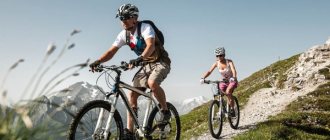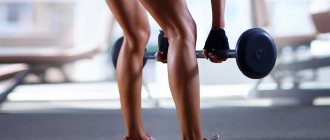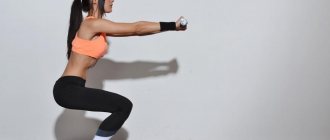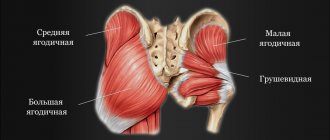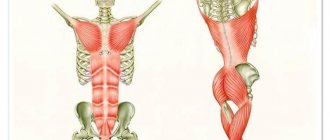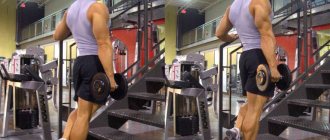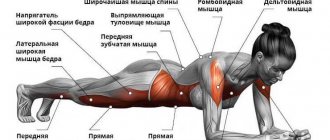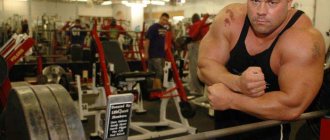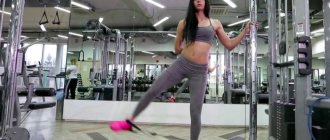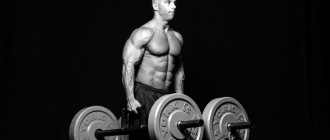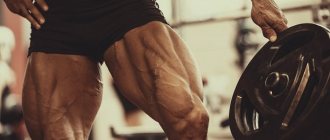Recently, the number of girls in gyms has been actively growing. They come there not only to get their body in order, but also to correct certain areas. A common problem among women is large calves, which spoil the figure and make it insufficiently feminine. How to remove calves - that’s what is interesting to ladies who have encountered this. You can solve this issue if you understand the reason why the volume of the calf muscles does not suit you.
Leg length
The correct leg length depends entirely on your height. This is logical, because a girl 155 centimeters cannot have legs 110 centimeters (that would look terrible). Everything must be proportional.
The ideal length is half your height plus a few centimeters. Much depends on whether you have wide or thin bones:
- wide bone: legs 2–4 centimeters longer than half the height (51–53% of height);
- normal bone: the length of the legs is equal to half the height and another 4–6 centimeters on top (52–54% of the height);
- thin bone: legs should be equal to half the height and another 6–9 centimeters (53–55% of height).
Remember that leg length is measured from the protrusion of the thigh bone to the floor.
Removing calves with exercises
Removing calves on the legs is quite difficult, since fat practically does not accumulate in the lower leg area, and its shape depends on the calf muscle. The fat layer may increase, especially in the cold season, but regular walking allows you to quickly restore your calves to their former slimness. Therefore, the best way to get rid of excess calf volume is to do a lot of long-distance walking. The advantage of walking is that it is suitable for everyone, regardless of fitness level.
How to remove calves from legs in a week is a question that many people ask. It is quite difficult to cope with the problem in such a short period of time, but there is no need to rush, because the result is more important. Jumping helps burn fat, but it also strengthens muscles, so you need to know how to properly include it in your program.
In order to quickly burn fat without pumping up your calves, it is recommended to combine three types of loads in your program
- multi-repetition strength;
- cardio;
- stretching.
Exercises should be performed for a minute without taking breaks. First, rise on your toes without dumbbells. Then jump from side to side. If breathing becomes difficult, pauses are acceptable. Do side jumps, skater style. They involve jumping from foot to foot, in which you need to tilt your body and move your bent leg back.
Dedicate the fourth minute to the plie position: place your feet wider than your shoulders, squat down and lift your heels off the floor one by one.
Fifth minute - stretching exercises against the wall. Put one leg back, rest your hands on the wall and lean forward, bending your left leg at the knee and touching the floor with your right heel. Spend 30 seconds on each leg.
The sixth last minute is devoted to stretching while bending over. One leg is placed forward on the heel. You need to lean forward with your body, keeping your back straight and pull your toes towards you.
This simple six-minute program helps in how to remove large calves. There are also a huge number of exercises aimed at burning fat in the lower leg area. You can find a separate article on this topic on the website, where the exercises are illustrated with photographs (link).
Hip Width
Girls most often worry about the size of their hips. Of course, hip girth is an important parameter for ideal legs. So, with a height of 161–165 centimeters, the correct hip circumference is 53–54 centimeters; with a height of 166–170, the thigh circumference is 55–57 centimeters; with a height of 171–175, the hip circumference should be 57–58 centimeters (be careful: the circumference of one hip, not the circumference of two hips).
We would like to note that 55 centimeters in girth is not so small, which means that thin and beautiful legs are not always the same thing.
Skirt
Well, don’t give up dresses and skirts completely, of course not. You just need to stay away from straight, tight skirts that will highlight large calves and ankles. Instead, choose A-line or flared skirts, they will slim your legs.
The best length for a skirt is knee-length, where the narrowest part of the legs is. Avoid hemlines with different additional details; such a hemline will contradict the positive effect of the skirt.
Another option for skirts for massive legs is maxi style or floor length, because they cover all problem areas.
Attractive knees
Knees can be both a decoration of the legs and their main problem. Good knees are small, rounded, neat, without protrusions on the sides. The knee should be the same distance from the top and bottom of the leg, midway between the top of the thigh and the foot.
Pay attention to the circumference of the leg under the knee: it should be equal to the circumference of the ankle or be slightly larger.
Unfortunately, the knees give away a woman's age. It’s not for nothing that Hollywood stars are starting to do plastic surgery on their knees in order to return them to their correct shape.
Pumped calves
Girls who have pumped calves are mostly professional athletes who regularly load their calf muscles, for example, by sprinting or strength training.
In order to cope with how to remove large calves on the legs, they need to minimize as much as possible any load on the calf muscle . It is recommended to replace sprint with cross-country. You should avoid strength exercises with weights that increase muscle volume, and choose those that are aimed at burning fat.
Healthy feet
Beautiful legs are, first of all, healthy legs. Spider veins and blue-violet mesh will ruin the appearance of even the slenderest legs. A sedentary lifestyle, sitting for seven to eight hours, high heels, lack of physical activity - all this can lead to varicose veins. The disease is serious and is often treated only with laser therapy or surgery.
Therefore, take care of the health of your feet from a young age. Walk, play sports, take a contrast shower, give your feet a break from heels, drink more water and visit a phlebologist.
Shoes
You love flats, but “they” don’t like you. Such shoes only emphasize large calves and ankles and make the legs look short. It is best to wear mid-heeled shoes to visually lengthen your legs.
The type of heel is also important. A chunky heel, solid heel or platform will create the balance you need with fuller legs. Avoid thin heels! which in contrast will show your legs even fuller.
Also remember, the lower the vamp (or toe of the shoe), the longer and thinner your legs will appear.
The most important point is that there are no horizontal ankle straps. They will draw attention to them and disrupt the proportions.
Smooth skin
Smooth and silky skin is another mandatory sign of ideal legs. You need to exfoliate a couple of times a week and apply a moisturizing body lotion every day.
There are several ways to get rid of unwanted hair on your legs: the simplest and most short-lived is shaving, the most expensive and effective is laser hair removal, the most optimal in terms of price and longevity is waxing, sugaring. Choose what you like!
More about slender and beautiful legs: Seven models of sandals that visually reduce the size of your feet.
How to eat healthy
Let’s admit right away: there is no separate diet for losing weight in calves. And this is natural. The body is our whole, and nutrition, be it right or wrong, will affect all parts of our body. A strict diet will only worsen the condition. Therefore, in pursuit of a slim figure, you need to eat right and healthy.
How many calories can you burn dancing?
First of all, the diet should be balanced
.
We include carbohydrates, fats and proteins. Of course, be sure to add vegetables and fruits
, which will fill the body with essential vitamins and fiber.
Carbohydrates
can be in the form of porridges, and if you can’t do without bread (do you already know about gluten?), then eat whole grain or yeast-free baked goods. Carbohydrates provide energy to our body and fight hunger.
Proteins –
a necessary building material for muscles (we have an article on this topic). They can be of both plant and animal origin. The main thing is to eat lean meat - baked, stewed or boiled.
The same goes for vegetables.
.
Not all vegetables can be consumed raw, but there are many wonderful recipes that will diversify your menu and make food consumption a daily holiday. Fresh salads are best seasoned with vegetable oil. It’s a matter of taste: olive, sunflower, flax and sesame are suitable. It’s not bad to add pumpkin, sunflower or sesame seeds to the salad. There are many meal options on sale now. We also recommend adding them to salads or cereals, since they are real weight loss products .
Don't forget about fresh fruit
.
Of course, it is better to eat fruits in accordance with the season
. Then they are maximally filled with vitamins and will bring you the most benefit.
We recommend following the basic principles of proper nutrition:
- fractional meals (often in small portions);
- healthy foods;
- sufficient amount of liquid (read more about how much water you need to drink);
- last meal no later than 3 hours before bedtime.
It should be noted that very often a large volume of calves can be a signal of swelling. To prevent water from retaining in the body, try to limit yourself to salty foods. And also eat foods containing potassium, as it absorbs sodium, which leads to swelling. Bananas, spinach, avocados, mushrooms, and chicken contain potassium.
Surgery for ankle fractures
With external transosseous osteosynthesis, traumatologists use a guide apparatus with thin metal wires passed into the ankle joint to compare and fix bone fragments. The skin is damaged only in the area where the needle is inserted. Immersion osteosynthesis, carried out through an incision in the skin and soft tissues, involves the use of metal structures of various shapes and purposes, with the help of which fragments of damaged bones are connected.
In intraosseous osteosynthesis, rods are used, in bone osteosynthesis, plates with screws are used, and in transosseous osteosynthesis, pins and screws are used. During an open access operation, the traumatologist examines the damaged area in detail and also gets the opportunity to use the most effective surgical techniques. The disadvantage of this technique is heavy blood loss, disruption of tissue integrity, and the risk of wound infection.
Surgical techniques for ankle fractures
For fractures of the lateral (outer) ankle, the surgical incision is made in the projection of the fibula - along the outer surface of the ankle joint. After removing blood clots and small bone fragments, the surgeon repositions the fragments and then secures them with a plate and special screws.
Surgical treatment of injuries to the medial ankle involves two stages. The first is an incision along the inner surface of the ankle joint, cleaning the cavity from small fragments and blood clots. The second is to restore the integrity of the injured bone, fixing the fragments with knitting needles and screws.
The technique of surgical treatment of a bimalleolar fracture is determined by the condition of the articular fork and deltoid ligament. If the fork has retained its anatomical position (there are no signs of bone divergence), osteosynthesis of the medial malleolus is performed, then the lateral one.
A fracture of two ankles, complicated by divergence of the fork, is the basis for emergency surgery. First, osteosynthesis of the medial malleolus is performed, then a second incision is made along the fibula, after which osteosynthesis of the tibia is performed. The final stage of the operation is the application of a plaster cast.
A fracture of the anterior lower edge of the tibia with medial subluxation of the foot is a common injury in athletes. The surgical technique is as follows: a long longitudinal incision is made, cutting the transverse and (sometimes) cruciate ligament, the tendons are pulled apart with blunt surgical hooks to expose the site of bone damage. The foot is bent and shifted back, the fragments are set, connecting them with metal rods (the pin is driven into the tibia). Next, the foot is extended and placed at a right angle. The hooks are removed, tissue is sutured layer by layer, and a plaster cast is applied to the knee.
A fracture of the lower posterior edge of the tibia with posterior dislocation of the foot is a difficult case in traumatology. The operation is urgent. The patient's position is face down. The incision is strictly parallel to the Achilles tendon, along the outer edge. After exposing the injured area, the fragments of the tibia are set, fastening the joining area with a screw or a special nail. The reduced foot is brought into a vertical position (at a right angle to the lower leg). With this type of fracture, it is technically difficult to remove metal structures after restoration of the joint, therefore, if possible, the technique of external transosseous osteosynthesis is used.
Metal fixators are removed 3-6 months after osteosynthesis. A full-fledged surgical operation is performed.
Is surgery necessary?
Among aesthetic surgeons, ankle liposuction is considered a highly controversial procedure. Some experts argue that ankle liposuction is useless because the shape and thickness of the ankles is determined by the genetic structure of the bone tissue.
Moreover, in this anatomical area there is not a large amount of fat, but there is a very high risk of damage to soft tissues and blood vessels. However, in some situations, specialists still agree to perform liposuction. But first of all, a consultation with a competent surgeon is necessary, who, after examining the patient, will determine whether there is a need for the procedure.
Preventing Knee Injuries
Knees are a commonly injured area among athletes and athletes, so it is important to approach leg training with extreme caution. If you notice that you're pushing your knees past your toes during lunges or hack squats, immediately adjust your technique or ask a trainer nearby to help you with the movement.
Your technique may be skewed due to fatigue or too heavy a weight. Either way, you need to stop and make adjustments before injury occurs. Don't let your knees shake during squats or lunge too far forward or to the side.
Control your technique and be sure not to bring your knees past your toes in every leg movement you perform.
And finally, our little motivational bonus for an extra boost to going to the gym!
Anatomy of the gastrocnemius muscle
The calves are made up of two main muscles: the gastrocnemius and the soleus.
The most important one is the calf muscle. Its main task is to raise the heels when we stand. It is worth saying that it is small, occupying 40% of the area. To examine the calf muscle, just stand on your toes.
The soleus muscle is located under the main muscle, it is visible only from the side. Its function is to raise the foot when we sit. It contracts slowly and occupies 60% of the volume of the calf.
